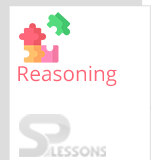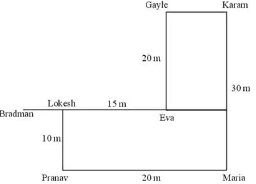 Introduction
Introduction
What is Reasoning Ability Test?
A logical reasoning test is a form of psychometric testing that is widely used by corporate employers to help assess candidates during their recruitment process. 'Psychometric' is just a fancy way of saying 'measuring mental ability' and logical reasoning tests are designed to measure your non-verbal skills. The article SSC CPO Reasoning Ability Quiz 10 provides Reasoning Ability questions with answers useful to the candidates preparing for Competitive exams, Entrance exams, Interviews etc.
 Quiz
Quiz
Direction(1-5): Study the following information to answer the given questions.
(A) Six plays are to be organized from Monday to Sunday-One play each day with one day when there is no play. 'No play' day is not Monday or Sunday.
(B) The plays are held in sets of 3 plays each in such a way that 3 plays are held without any break ie, 3 plays are held in such a way, that there is no 'No play' day between them but immediately before this set or immediately after this set it is 'No play' day.
(C) Play Z is held on 26th and play X was held on 31st of the same month.
(D) Play B was not held immediately after play A (but was held after A, not necessarily immediately) and play M was held immediately before 'Q'.
(E) All the six plays were held in the same month.
1. Which play was organized on Monday ?
Where * = Holiday
2. Answer - Option A
3. Answer - Option B
4. Answer - Option D
5. Answer - Option C
- A. Z
B. M
C. Q
D. Cannot be determined
E. None of these
- A. Tuesday
B. Monday
C. Wednesday
D. Cannot be determines
E. None of these
- A. 26th
B. 28th
C. 29th
D. Cannot be determines
E. None of these
- A. Play B is held immediately before play M
B. Play Z is held after play B
C. There was a gap after 2 plays and then 4 plays were organized
D. First play was organized on the 25th
E. Play B was held on Friday
- A. Friday
B. Wednesday
C. Saturday
D. Cannot be determined
E. None of these
| Day | Mon | Tue | Wed | Thur | Fri | Sat | Sun |
| Date | 25 | 26 | 27 | 28 | 29 | 30 | 31 |
| Game | A | Z | B | * | M | Q | X |
Direction(1-3): In each of the following questions, assuming the given statements to be true, find which of the following options holds true:
1. Statements:
S ≥ T, T > N, N ≥ R = G, P < G, P ≥ J
Conclusions:
I. T > G
II. R ≥ P
- A. Only conclusion I is true
B. Only conclusion II is true
C. Either conclusion I or conclusion II is true
D. Neither conclusion I nor conclusion II is true
E. Both conclusions I and II are true
- A. If only conclusion I is true.
B. If only conclusion II is true.
C. If either conclusion I or conclusion II is true.
D. If neither conclusion I nor conclusion II is true
E. If both conclusions I and II are true
- A. If only conclusion I is true.
B. If only conclusion II is true.
C. If either conclusion I or conclusion II is true.
D. If neither conclusion I nor conclusion II is true
E. If both conclusions I and II are true
- A. 10 m
B. 15 m
C. 20 m
D. 5 m
E. 25 m
- A. 10 m
B. 15 m
C. 20 m
D. 5 m
E. 30 m
Direction(1-5): Study the following information carefully to answer the question.
Seven friends Garima, Himani, Jivika, Komal, Latika, Mouli and Nishita are working in different cities viz Kolkata, Lucknow, Chandigarh, Dehradun, Delhi, Agra and Bhopal, but not necessarily in the same order. Each one of them has a different professions viz, Teacher, Photographer, Banker, Company Secretary, Charted Accountant, Editor and Painter, but not necessarily in the same order.Himani is a Editor and she works in Dehradun. Komal is a Photographer and she does not work in Kolkata. The teacher who works in Lucknow. Mouli works in Delhi. The Painter works in Bhopal. Latika is a Charted Accountant and she works in Chandigarh. Garima is a Company Secretary. Jivika does not works in Lucknow.
1. Who is the Banker?
2. Answer - Option E
3. Answer - Option D
4. Answer - Option B
5. Answer - Option E
- A. Jivika
B. Nishita
C. Komal
D. Mauli
E. None of these
- A. Garima - Company Secretary - Chandigarh
B. Komal - Painter -Bhopal
C. Latika - Charted Accountant - Lucknow
D. Mouli - Editor-Dehradun
E. None of these
- A. Jivika
B. Komal
C. Mouli
D. Nishita
E. Data inadequate
- A. Agra
B. Kolkata
C. Lucknow
D. Chandigarh
E. None of these
- A. Nishita
B. Jivika
C. Mouli
D. Garima
E. None of these
| Person | City | Profession |
|---|---|---|
| Garima | Kolkata | Company Secretary |
| Himani | Dehradun | Editor |
| Jivika | Bhopal | Painter |
| Komal | Agra | Photagrapher |
| Latika | Chandigarh | Charted Accountant |
| Mauli | Delhi | Banker |
| Nishita | Lucknow | Teacher |




